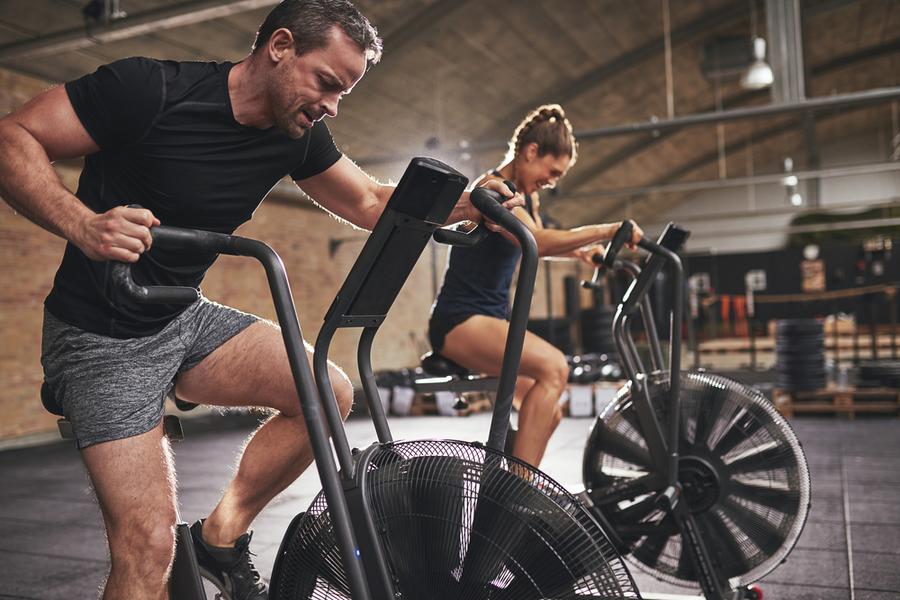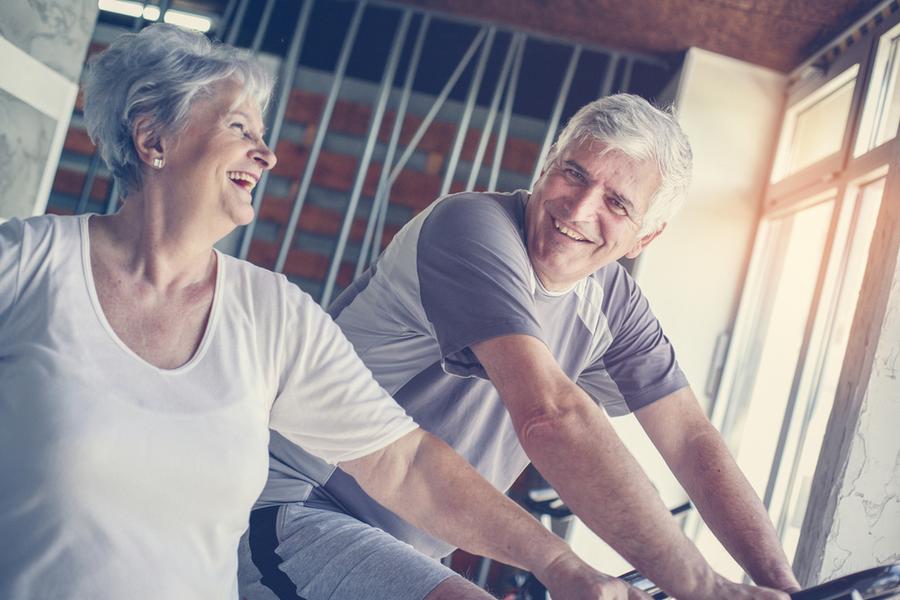All About Cardio: When is the Best time of day to work out?
Cardiovascular health is an integral part of any well-rounded fitness routine. If you’re wondering how to maximize your cardio-related activities, you may have wondered when is the most optimal time of day to do your cardio exercises, what you should eat pre- and post-workout, and what the physical and mental health benefits are.
Doing cardio in the morning, afternoon, or evening each has their unique pros and cons, and many concerns come down to a person’s lifestyle and energy levels. Choosing healthy foods is also an integral part of ensuring you give your muscles the fuel they need. Finally, for those who avoid cardio exercises like the plague, you could be missing out on some pretty profound physical and mental health benefits.
Read on for more information about how to structure your workouts and integrate cardio exercises so you can get the most out of your routine and reap the ideal benefits.
What is Cardio?
Cardiovascular exercise, or “cardio” for short, refers to when a person engages in a type of exercise that raises their heart rate and causes them to breathe more heavily. This triggers physiological changes in a person’s body.
There are two different types of cardio to know about: aerobic and anaerobic. Aerobic exercises involve sustained effort over a longer period of time and include things like running, cycling, rowing, or swimming laps. By contrast, anaerobic exercises involve quick intervals of intense exercise for a short period of time, such as sprinting, jumping, and heavy weight-lifting, or doing mountain-climbers or burpees.
What do these different types of cardio do to your body, though? Both are beneficial, but have varying benefits.
Aerobic exercise stimulates your heart gradually by getting your heart and breathing rates up over a sustained period of time. You are able to effectively build endurance when engaging in this type of cardio. Aerobic exercise allows you to send oxygen and nutrients through your body, as well as increase your oxygen consumption (Weil, n.d.). It is important how efficiently your muscles consume oxygen, because oxygen inside the muscle is used to burn fat and carbohydrates for fuel – and the more efficient your muscles are, the more fat and carbs you can burn. This keeps us fit and allows us to work out for a long period of time without tiring or fatiguing.
Conversely, anaerobic exercise raises your heart rate quickly. Now imagine running as fast as you can and then stopping, and doing that multiple times in a short period of time. When you engage in anaerobic exercise consistently, you increase your body’s energy reserves, which increases your overall energy levels (Bubnis, 2019). Specific benefits of anaerobic exercise include increased bone strength/density and allows you to lose pounds and maintain a healthy weight (Bubnis, 2019).
Alternating between the two types can help keep your heart and lungs strong, and it is easy to include both in your fitness routine. For example, you could warm up slowly by walking on the treadmill at a normal pace, then following up with interval training which involves raising the speed levels much higher, sprinting and stopping, then repeating this multiple times.
Physical Benefits of Cardio Training
There are unique benefits to each type of cardio training. During aerobic exercise, you are reducing your risk for chronic health conditions like heart disease, type 2 diabetes and stroke. Other benefits include sustained weight loss, lower blood pressure levels, increased stamina, and strengthening of the immune system and heart (Chertoff, 2018).
When you engage in anaerobic exercise, you are strengthening your bones, burning fat, building muscle and building increased stamina (Chertoff, 2018). If you already include High Intensity Interval Training—or HIIT—into your routine, you are already effectively integrating anaerobic exercise.
Many people think doing cardio constantly will help them lose weight. However, this is only part of the story. Combining cardio with weight and resistance training is a more effective method of achieving this goal. Only doing cardio might lean your body out, but will not help you build muscle tone and definition.
In addition to strengthening your heart and lungs, cardio can also help you reduce your cholesterol and blood pressure numbers, which becomes increasingly important as we age.
Mental Health Benefits of Cardio Training
The benefits of cardio training go beyond just the physical. Mental health benefits include improved mood and sleep, as well as mitigating feelings of depression.
These benefits transcend age, gender and ethnic background. In a randomized research study conducted in Iran involving two groups of female college students ranging in age from 19 to 26, one control group did not receive any intervention, and one group participated in aerobic training designed by the researchers. As part of this, the experimental group of women worked out twice per week for 10 weeks with a 48-hour rest period in between sessions (Arazi, Benar, Esfanjani, & Yeganegi, 2012). Each session lasted 40 to 50 minutes and included 15 minutes of warm-up. The participants in this group reached a maximum heart rate of 60 to 80 percent. Members of each group were given questionnaires pertaining to symptoms of anxiety, depression, and stress (Arazi, Benar, Esfanjani, & Yeganegi, 2012). The control group who did not receive any intervention experienced no changes in terms of their mental health symptoms.
In another study, patients who had heart failure and an implanted defibrillator were assigned to a 12-week aerobic interval training program. The researchers assessed their depression and anxiety levels following the 12-week program and again two years later. They found that the aerobic training group showed significant improvements in several of their questionnaire subscores pertaining to anxiety and depression after the 12-week program ended. At the two year mark, their scores moved toward baseline or remained stable (Isaksen, Munk, Giske, & Larsen, 2016).
How often should you engage in Cardio Training?
The United States Department of Health and Human Services recommends people engage in at least 150 minutes of moderate aerobic activity or 75 minutes of vigorous activity per week, or a combination of the two (HHS.gov, 2019). Experts recommend that people engage in some sort of activity every day, which can have profound health benefits.
“We suggest doing cardio anywhere from four to five times a week for a safe yet efficient frequency,” according to Miles Dean Garcia, CEO and Owner of Fit2Fly Fitness, a mobile personal training company based in Los Angeles, California.
If you’d like to build up slowly, try taking the stairs instead of the elevator, or parking your car further away in the grocery store parking lot.
If you are already a seasoned exerciser and are looking to bring your training to the next level, vary your routine by introducing new formats. If you usually run, try swimming or biking.
If you usually get your fitness fix at a gym or boutique studio, try a new class format. Zumba, HIIT, and cardio barre classes are great ways to raise your heart rate, but balancing those with other class types can keep your body strong.
If you are not sure how to choose what type of cardio-related activity to engage in, think about what your goals are.
“If someone is looking for weight loss, we would suggest doing some sort of high intensity/low intensity combination. If it’s for endurance, then perhaps long-distance, steady pace types of cardio like jogging and running would be ideal. Finally, if someone is looking to increase strength, then some type of cardio that incorporates resistance, such as running uphill or upstairs would work best,” Garcia suggested.
What is the Best time of day to do Cardio Training?
In terms of the best time of day to do cardio training, there is no clear consensus from a research standpoint. Instead, there are a few factors to consider when structuring your exercise routine – such as your lifestyle, energy level, and sleep goals.
Doing cardio first thing in the morning can help wake you up, raise your energy levels for the day, and boost metabolism and mood (Larbi, 2018). For individuals who are busy and feel like they are constantly trying to find pockets of time in the day to work out, knocking out their workout early in the AM can help with their alertness, greater sense of strength, vitality and accomplishment, and a more mindful connection to the body (Kahn & Biscontini, 2007).
Current research does not show a clear distinction between what time of day a person chooses to work out. However, a lot of research focuses on the state your stomach is in during a workout.
Some experts swear by fasted cardio, in which you work out on an empty stomach, citing greater fat-burning capabilities. However, there is no true consensus on whether or not it is more effective to work out on an empty stomach.
In one study, researchers examined the effect of training in a fasted state versus working out with food in the stomach. They divided the 20 physically healthy men who took part in the study for 6 weeks into two groups in which one did the exercise in a fasted state, and one group ate carbs before and during exercise. For the men in the experimental group, they found that the capacity for their muscles to receive oxygen was higher, and that training in a fasted state prevents blood glucose crashes (Van Proeyen, Szlufcik, Nielens, Ramaekers, & Hespel, 2011).
Another study focused on the kinds of calories burned during fasted state versus a fed state. In the study, two groups of men went for a morning run either after eating breakfast or in a fasted state. For the group who skipped breakfast, they burned 20 percent more fat on average (Finn, 2018).
When it comes to what the fitness experts think, time isn’t as important as the actual engagement in heart-healthy activities.
“I would suggest doing cardio in the morning because of the benefits, but any time is a good time for a healthy habit,” said Garcia.
What to Eat before Cardio Training?
When it comes to cardio training specifically, what you eat is important – but so it when you eat it. For example, it’s key to fuel up before your workout and choose an item that is low in fat and sugar, high in carbs, and has a moderate level of protein. Smoothies made with fruit, veggies and milk can be a great way to make something easy and on the go. If you’re in a rush, grabbing a protein bar is also advisable.
Avoid eating a large meal before engaging in cardio, as it can make you sick. Instead, make sure to eat 60 to 90 minutes prior to your workout to give your body time to digest and fuel your working muscles. About 20 to 30 minutes after your workout, you will want to eat again because your body has a metabolic window in which your muscles can absorb nutrients in an efficient manner (Murray, 2016). You should be eating items containing carbs and protein, as this combination helps with muscle recovery and reduction in soreness. Snacks like chocolate milk can work well.
Depending on the level of intensity of your cardio workout, what you eat will vary. For lighter sessions, focus on choosing a small snack and rehydrating with water. A snack can be toast with avocado or peanut butter, Greek yogurt, apple and peanut butter, a few crackers and cheese, or a handful of nuts with dried fruit (Bruno, 2016). After more intense sessions, your body will need more grams of carbs and protein. Healthy snacks like a peanut butter and banana sandwich, turkey wrap and veggies, fruit smoothie with Greek yogurt, or hummus and tomato on pita bread are all good choices. In fact, you can make these snacks ahead of time and stash them in your workout bag or gym locker.
Avoiding Injury
As always, avoiding injury should be the goal when engaging in any type of physical activity. Common injuries pertaining to cardio training include overused and sprained muscles. To avoid these, make sure you properly warm up and cool down.
A warm-up can consist of stretching, walking on a treadmill, or doing some jumping jacks or leg lifts. A proper cool-down can consist of walking and stretching.
Ensure you have good form when doing exercises like weight lifting, running on a treadmill or using an elliptical. When in doubt, consult with a trainer if you are in a gym or watch YouTube videos from reputable sources to learn about proper form.
Conclusion
Integrating activities that emphasize cardiovascular functioning can take your fitness regimen to the next level. Varying your routine by mixing in aerobic and anaerobic cardio activities can keep things interesting and cross-train your body.
Fueling your body with the right foods will help you reach your fitness goals. Choosing snacks that contain an optimal balance of carbs and protein before and after your workouts will give your body the energy it needs to perform at its highest level.
When it comes to what time of day to do cardio, you should choose what works best for you. If you are an early riser, it may be best to knock your cardio workout first thing in the morning. If you want to relieve stress and unwind from your day, opt to do cardio in the afternoon or evening.
Regardless of the time of day (or night) you select to cardio, engaging in the recommended amount of exercise will keep you feeling healthy, strong and allow you to reap the physical and mental health benefits of this exercise.
By Nicki Karimipour, PhD

Dr. Karimipour has previous experience in writing and editing for both print and online publications, and in teaching journalism, health writing, and public relations at the undergraduate and graduate level.
Her professional experience ranges from clinical research program management to collaborating with medical researchers and consulting on clinical trials, to developing and disseminating messages about health research. Dr. Karimipour’s own research focuses on a variety of health topics, such as effects of social media use on female body image, football and concussions, and e-cigarette use among youth. Her research has been published in the Journal of Clinical and Translational Research, the Journal of Behavioral Health Services & Research, and the Journal of Sports Media.
She is based in Los Angeles, California and currently works at the University of Southern California in a Director-level communications role. Follow her on Twitter: @NickiKPhD
References
Arazi, H., Benar, N., Esfanjani, R. M., & Yeganegi, S. (2012). The effect of aerobic training on perceived stress, anxiety and depression of non-athlete female students. Acta Kinesiologica , 6, 7–12. Retrieved from https://pdfs.semanticscholar.org/1740/7f9c71eeafc859247991eecc9fced5ba6e10.pdf
Bruno, A. (2016, July 15). The Best Snacks To Eat After A Cardio Workout. Retrieved from https://www.self.com/story/the-best-snacks-to-eat-after-a-cardio-workout.
Chertoff, J. (2018, August 31). What’s the Difference Between Aerobic and Anaerobic? Retrieved from https://www.healthline.com/health/fitness-exercise/difference-between-aerobic-and-anaerobic.
Finn, C. (2018, November 7). Does Exercising Before Breakfast Help You Burn More Fat? Retrieved from https://www.vice.com/en_us/article/8xp9gg/does-exercising-before-breakfast-help-you-burn-more-fat.
HHS.gov. (2019, February 1). Physical Activity Guidelines for Americans. Retrieved from https://www.hhs.gov/fitness/be-active/physical-activity-guidelines-for-americans/index.html.
Isaksen, K., Munk, P. S., Giske, R., & Larsen, A. I. (2016). Effects of Aerobic Interval Training on Measures of Anxiety, Depression and Quality of Life in Patients with Ischaemic Heart Failure and an Implantable Cardioverter Defibrillator: A Prospective Non-Randomized Trial. Journal of Rehabilitation Medicine , 48(3), 300–307. Retrieved from https://www.ingentaconnect.com/content/mjl/sreh/2016/00000048/00000003/art00009
Kahn, J. E., & Biscontini, L. J. M. (2007). Morning Cardio Workouts. Human Kinetics.
Larbi, M. (2018, October 10). What is the best time of day to workout? From weights to cardio, here’s how to maximise weight loss. Retrieved from https://www.thesun.co.uk/fabulous/7452473/best-time-of-day-workout-weights-cardio-maximise-weight-loss/#:~:targetText=Morning – fasted cardio (best for fat burning)&targetText=One study, published in the,first meal of the day.
Murray, L. (2016, May 6). What to Eat Before and After Every Kind of Workout. Retrieved from https://www.health.com/fitness/workout-food.
Van Proeyen, K., Szlufcik, K., Ramaekers, M., & Hespel, P. (2011). Beneficial metabolic adaptations due to endurance exercise training in the fasted state. Journal of Applied Physiology, 110(1), 236–245. Retrieved from https://www.physiology.org/doi/full/10.1152/japplphysiol.00907.2010
Weil, R. (n.d.). Aerobic Exercise Definition, Types, List, and Benefits. Retrieved from https://www.medicinenet.com/aerobic_exercise/article.htm.






 Compact/Folding
Compact/Folding Front Drive
Front Drive Rear Drive
Rear Drive